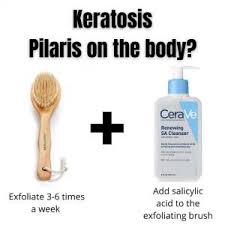
Is Salicylic Acid Good for Keratosis Pilaris?
Have you noticed that the skin on your arms, cheeks, or thighs often has a bumpy texture? Have you ever wondered what it is and why you suffer from it? It could be keratosis pilaris, also known as chicken skin, which is a common problem many of us have. With that in mind, we made it our mission to learn more about this genetic condition and whether salicylic acid is good for keratosis pilaris.
Before we dive in: If you want to learn more about salicylic acid, read our blog post. For those who just need a quick reminder, here are some examples of what salicylic acid can do for your skin.
What is salicylic acid? How does it affect your skin?
Salicylic acid is a popular acne-fighting ingredient that belongs to the beta-hydroxy acid (BHA) family. It can offer a lot of benefits, especially for those who suffer from frequent breakouts.
Salicylic acid is oil-soluble, which means it penetrates deeper into the skin than other acids, such as the popular AHA, glycolic acid. It removes impurities like excess sebum, dirt, bacteria, and more from your pores.
Salicylic acid removes dead skin cells that build up on the skin’s surface, causing spots and blackheads and making the complexion appear dull.
Salicylic acid removes the barrier of impurities that build up on the skin’s surface, allowing other skincare formulas to absorb quickly.
What is keratosis pilaris?
Keratosis pilaris is a common skin condition that occurs on the skin when a buildup of keratin, a harmless but unsightly hard protein, occurs. This causes clogged pores and creates rough skin with small bumps under the skin. The texture and appearance of the skin is similar to what many sufferers refer to as chicken skin, and the skin often breaks out suddenly throughout the year, especially in the winter.
There is no real cure or understanding of how and why people develop keratosis pilaris, but there are skincare ingredients that can help reduce the severity of keratosis pilaris.
Which acid is best for keratosis pilaris?
There are a variety of acids that can help fight keratosis pilaris. Members of the AHA and BHA families are most commonly used because they provide chemical exfoliation. These acids are found in products such as toners, cleansers, and serums, all of which are found in over-the-counter formulas. If you’re looking for something more impactful, consult with a trained professional to find an effective treatment or medical product to incorporate into your daily routine.
The best acids for keratosis pilaris are:
Lactic Acid
It’s considered the gentlest of the AHAs because its molecular size is too large to penetrate too far and cause irritation. It also contains hydrating properties that allow the acid to exfoliate while locking moisture into the skin barrier. This not only restores your complexion’s radiance, but also strengthens the skin and ensures it can protect itself from free radicals, such as UV rays, pollution, and other environmental influences.
Salicylic Acid
Many people with oily skin and acne use salicylic acid, which is more effective than lactic acid. This is because it’s oil-soluble, which means it can penetrate deeper than lactic acid and clear out pore-clogging bacteria, dirt, and debris. If you have sensitive skin, I would avoid salicylic acid because it’s too strong and can cause irritation.
Glycolic Acid
Glycolic acid is derived from sugar cane and is one of the most popular AHAs. It’s somewhere in between lactic acid and salicylic acid in terms of what it does to the skin. Its molecular size is smaller than lactic acid, but not as small as salicylic acid. Therefore, it is an effective ingredient for normal skin. You will also find that glycolic acid can be used twice a day, especially when it is included in the skin care products that rinse the skin.
Is glycolic acid better or salicylic acid for keratosis pilaris?
Both acids are effective in clearing keratosis pilaris from the skin. Your choice ultimately depends on how your skin reacts to the acid. As I mentioned before, salicylic acid is more effective than glycolic acid and can cause irritation. This is the main problem with using these active ingredients on the face instead of the body. The skin on our bodies is a little tougher. The best way to determine which acid you should use is to do a 24-hour patch test before applying it all over your skin. To do this, apply a 10-penny-sized amount of the product to the inside of your forearm and leave the product there for 24 hours. If there are no signs of irritation, you are good to go. If you have any questions, always consult a doctor or dermatologist.
What can get rid of keratosis pilaris?
There are several ways to treat keratosis pilaris at home. Here are some examples of proven methods that are simple and effective for treating KP.
Start by gently exfoliating your skin in the shower. By this I mean using a loofah or washcloth to loosen the bonds of dead skin cells so that they can fall off more easily with the following steps in this routine.
After gently exfoliating, apply a chemical exfoliant that can be applied directly to the skin after bathing. The best peels are glycolic, salicylic, and lactic. You will also find body lotions that contain urea that also remove dead skin cell buildup.
Finish by applying a moisturizer that contains hyaluronic acid or other moisturizing ingredients to nourish the skin. You should choose an oil-free formula to prevent the hair follicles from becoming clogged again.
This is an example of the simplest way to care for your skin. Unfortunately, there is no known treatment for keratosis pilaris that will completely eliminate the condition. But this routine will help you deal with any flare-ups.
What should I avoid if I have keratosis pilaris?
There is a lot of information on ways to reduce the build-up of keratin in the skin through dietary changes. People who have eliminated gluten from their daily diets have found that they suffer significantly less from KP flare-ups. Others also find that cutting out spices, oils, and lactose can help relieve their symptoms.There’s no scientific backing for this, though, so I recommend talking to your doctor if you want to know more.
How long does it take for keratosis pilaris to completely go away?
The average time for keratosis pilaris to completely go away is 4 to 6 weeks. This happens after consistent use of the best product formulas, and even finding the right skincare products often takes some time.
If you want to eliminate keratosis pilaris from your skin, you’ll need to maintain a daily routine to ensure that breakouts are kept to a minimum.
Here’s more information on whether salicylic acid helps treat keratosis pilaris. With any luck, I hope I’ve cleared up some of the confusion surrounding this skin issue, but if you have any other questions, follow us on Instagram!


